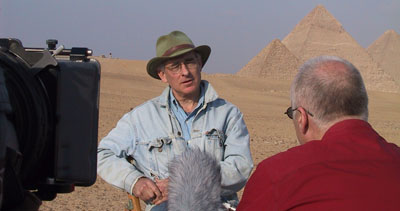“Quite a pile”

I’m back in Egypt with the crew shooting the Eternal Egypt documentary. Everything’s going as expected: the hurry-up-and-wait of the film business multiplied by the hurry-up-and-wait of Egyptian life.
We interviewed Mark Lehner today. Along with Zahi Hawass and in addition to referring to the Great Pyramid as “quite a pile,” he’s most (recently) known for his discovery of the “workers’ village” (photos), the urban complex of the pyramid-builders at Giza. He’s a fascinating guy and, like Kent Weeks, wonderfully articulate about the importance of what he’s doing. You’ll have to wait for the documentary for the full scoop, but something he said today really made me think. He was explaining how astonishing the pyramids of the Fourth Dynasty are, given their precision and size. Importantly, he noted that no undertaking on their scale in the time it took to build them was ever duplicated in ancient Egypt. He then made a quick aside — I’ll bet it’ll end up on the cutting-room floor — that this burst of activity and innovation can be likened to the US space program’s accomplishments in the 1960’s. The implication is that we’ve not achieved anything comparable in the 35 years since we landed on the moon. Which, of course, is true as far as manned spaceflight goes.
But it got me thinking. There are many, many people who believe the only way to explain the Giza pyramids is to turn to supernatural forces, lost civilizations, or alien intervention. “Pyramidology” is an entire pseudo-science dedicated to these claims and there is no shortage of TV programming that laps it up. So I ask, if we are unable to get out of low-Earth orbit in the coming decades will the popular imagination begin to search for extra-human explanations as to how we accomplished the moon landings in the first place? That is, if enough time passes after a watershed technical achievement is it inevitable that humans will seek to explain its occurence in non-human terms? Certainly, there is a fringe that always does, but I wonder if technical singularlites like the Apollo program are doomed to mystification if not repeated. Can’t we just go to Mars and not find out?
Linguistic sidenote. The location producers here in Egypt are known as “fixers” and they are a three-person family team. They are extraordinarily good at what they do. They are also near-anagrams of one another: Romany, Ramy, and Mary. Wish I had thought of that with my kids.
Safety dance
Did anyone catch this weird one-point safety in the Texas-Texas A&M game on Friday? I was at the game and it was hilarious to see the crowd erupt in cheers at the awarded point (after the botched extra point) while virtually no one knew or understood what the hell they were cheering for. I’m no football scholar, but huh?
I promise no more 80’s song title references. Got carried away. Sorry.
Jeff Berg
I’ve always been mesmerized by the work of designer Jeff Berg. His primary medium is Flash, but he’s savant-like in a variety of areas. Weather, subway signage, geometry — it’s all fodder for visualization and interaction. Plus, he’s pretty good at his day job.
99 Luft

OK, not only does Lufthansa have one of the only in-air Internet connections available (allowing fun stuff like this), but I just learned that they have a flight from Chicago to Dusseldorf on a flipping 737 that is 100% business class seats. Just 28 or so. I didn’t even know a 737 had that kind of range. Like a Southwest flight deciding to re-route to Europe. Except without the free-for-all for seats. Crazy. And Dusseldorf. Huh? Kraftwerk, I may make the trip after all.
The tech support generation calls the help desk
I call my parents’ house the Museum of Technological Dereliction so I naturally chuckled when I read this piece about the “tech support generation” — people who return to their parents at the holidays and whose time is mostly occupied with debugging technology issues. Until I showed up at my in-laws, that is. Not funny anymore. It isn’t that I’m asked to fix things, but that I am incapable of not doing so. For example I can’t not intervene when my father-in-law is cursing his all-in-one remote because its interface complexity rivals a CAD program. Similarly I can’t sit by idly while my in-laws watch a standard-def football game on their 61″ High-Def LCOS TV completely oblivious to the fact that a perfectly good high-def version of the same show is on another channel. This isn’t their fault.
I have a specific suggestion on this point. Why not build HD receivers/televisions such that they can alert the viewer when standard-def programming is being watched that also is currently being broadcast in high-def? All the data is there; cable and satellite high-def receivers obviously have all the programming information stored. And most people don’t know when a show has a high-def counterpart. In addition, it would be great if high-def televisions automatically sensed the type of input — DVD, high-def, or standard-def — and changed the aspect ratio accordingly. It pains me to see my in-laws watching standard-def programming warped all over the screen in order to fill it. This is an easy technical problem to solve, it seems to me. Perhaps it has been?
Happy Thanksgiving, America.
Big!
Confession. I love watching Big!, the series on Discovery HD Theater where a team of welders, metal fabricators, and gadgeteers come together to build oversized versions of appliances and other everyday items. There’s interpersonal drama, mostly staged or instigated — but even conflict is humorous because you quickly remember that the bickering is over a gigantic toaster or some such. Not to trivialize things, but, c’mon, you’re not repairing aircraft here, folks. Maybe I like it so much because I’m really not handy and so seeing things built supersize makes it easier to comprehend their inner workings. Or maybe it is because blowtorches look great in high definition.
Speaking of, I don’t watch much television but what I do watch these days seems mostly to be in HD. I wonder if I could pull off watching only high-definition programming in 2005. Could be my first resolution.
Re-MoMA

The Museum of Modern Art in NYC re-opens to the public tomorrow after a two-and-a-half year absence from Manhattan. I’ve been in the new space a few times during construction and last night I was lucky enough to go to the re-opening party. More on that in a second. First, the building. Impressive. There’s a new spaciousness to the galleries that really allows the works of art to exist in meaningful relation to one another rather than simply next to one another. Yoshio Taniguchi has made some great choices with interior windows and portals, teasing visitors (spot Matisse’s Dance ) with snatches of art seen from afar. Perhaps my favorite part of the new architecture are the windows (specially treated to minimize direct sunlight) that look out onto the sculpture garden and the museum’s “architectural neighbors” in Midtown. Upcoming tours available in the museum will actually make a point of commenting on the architecture visible from the windows, an extension of the museum’s architectural holdings — literally a museum outside the walls. I like that concept.
The party was well done. DJ’s on every floor, a band on the top floor, open bar, cafés turned into hip lounges. One can’t complain. No red wine though. “We’re MoMA. We don’t do red wine,” I was told. I wasn’t cool enough to construct a comeback so I can only think he meant they don’t serve red wine because of the staining possibilities. But maybe there’s another story. Like, we’re MoMA and red wine is so The Whitney.
A few photos of the space and event are available.
“Floating Enthusiast”
Can one be enthusiastic about floating? Not sure. But my wife certainly can be mortified that I let a news crew into our bathroom. Here’s the full clip (Quicktime). Note: the iron wasn’t even plugged in and that is not me in the tank. Body double.
Sensory deprivation

I spent an hour in a sensory deprivation tank a few weeks ago. A friend of mine and I did it together (though not, you know, together). Basically you crawl into a small capsule (pictured above) and lay down into 10 inches of water that’s absorbed 800 pounds of salt. So, you float without effort as in the Dead Sea. The water is warmed to body temperature. There is no sound and no light whatsoever. You can, of course, get out at any point and I did do a bit of feel-around exploration when I got in to allay any panic. The idea is to promote extreme relaxtion (and perhaps other extreme modes of being). Not sleep, exactly, but more like a prolonged hypnagogic state — that weird not-awake, not-asleep period just before you drift off. What’s most striking in retrospect is that, once I got situated, my first thought (and the closest I came to panic) was “what the hell am I going to do for an hour?” I guess that means I needed sensory deprivation. Before long — it is utterly impossible to assess the passing of time — I was just floating, being, not really thinking of anything. My father-in-law is an avid meditator and I can only imagine it was something like that. I did rub my eyes once. Bad idea in the salt solution. All senses deprived except for the sensation of excruciating eye pain! Once out I felt totally refreshed, as though I had taken a long nap. That night at a dinner party I mentioned to friends what I had done. Then, I essentially forgot all about it.
That is, until last week when one my friends — a producer for ABC News — called me up to say that they were going to do a story on sensory deprivation, spinning it as the high-tech answer to the hectic pace of modern life. Oh, and would it be OK if I were interviewed? Sure, I said, thinking I’d just do a quick phone interview. Silly me. They wanted to come to my house and film me being the harried working dad: taking conference calls, working online, changing the baby’s diapers, packing for my business trip, and so on. The irony of it all was that my wife was out of town on business — the first time she’d had to do that in years — and so I really was a bit harried. I called her to see if it was OK to let a TV crew into our house — a house, mind you, that me and two small children had had to ourselves since she was gone. When she picked herself back up off the floor she noted that anyone who saw the newscast would know that it was a complete fabrication and that our nanny was hovering just off-camera. Jealousy, I thought, from an absentee mother. Finally my plight as an overworked father would be known.
The piece is supposed to air in Chicago on ABC at 10:00 PM tonight as part of a ‘Healthbeat’ segment.
It’s a blast from the past but can it really relieve stress? Some say you can float your troubles away. Some people are rediscovering a water technique that shuts out the world. Could just one hour in a special tank not only cut your stress but help with everything from pain relief to fatigue?” Watch “Healthbeat: A Stress Solution?”
I’ll digitize the clip, if possible. Update: the whole segment has been digitized by one of the other people who appears in it. Float on.
Oh, by the way, the lady pictured above wasn’t in my tank. That wouldn’t be deprivation, now would it?
Hot off the grid(dle)

Today the World Community Grid opened to the public. Basically IBM has developed a distributed computing system (think SETI@Home) for tackling major problems in science and health, all with a humanitarian bent. Coverage in the Times and the Trib.
Rejoice, for now you can satisfy your hitherto unmet desire to crunch human proteome data with your computer’s free processing cycles.















